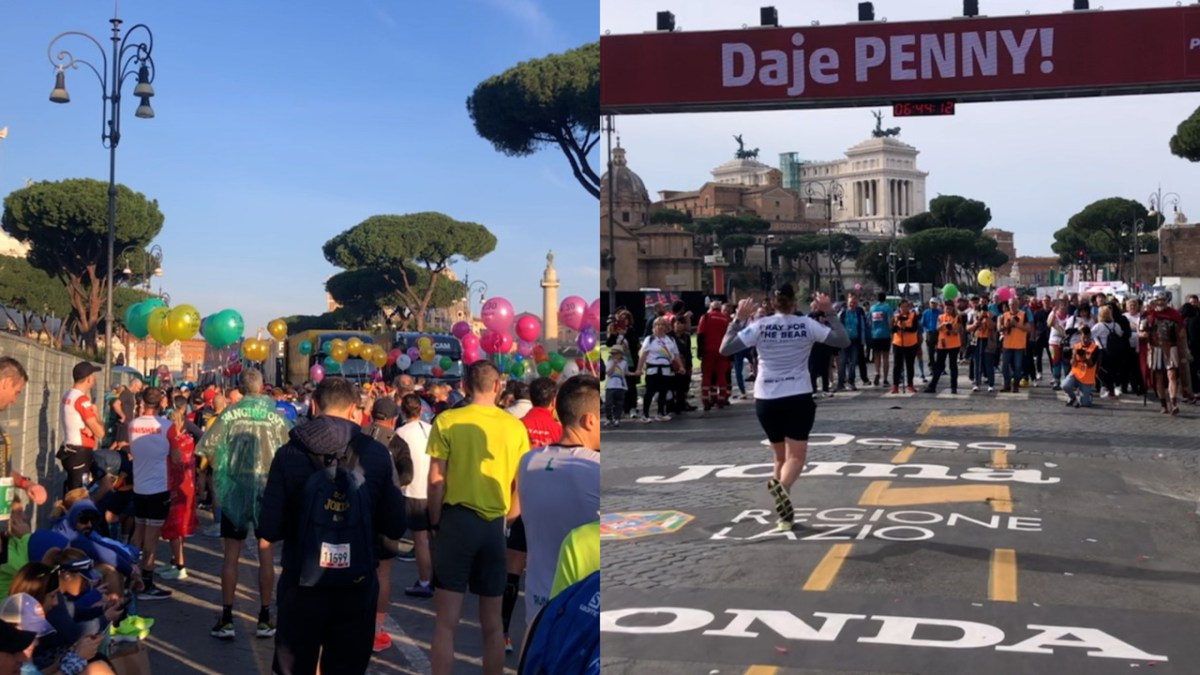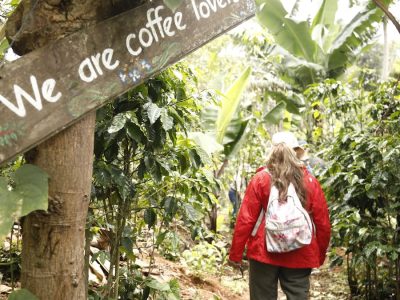As the sun rose over the Colosseum and the mist burnt off the Temple of Saturn, I took in the scene on the Via dei Fori Imperiali. Five minutes before the start of Rome’s annual marathon, 19,000 nylon-clad hardbodies limbered up to a marching band’s rousing rendition of Fratelli d’Italia, the national anthem. This was more crowd than I was used to in Rome — even at the Forum, where millions come each year to tread in the footsteps of the Roman senators. It was a meaningful setting for all the nervous energy.
As the runners hurtled off in a cloud of green, white and red confetti, I felt decidedly less nervous. I would be following them around the slender arches of the Circus Maximus, past grooves in the ancient earth worn away by horse-drawn chariots, but at a far more relaxed pace. Because I hadn’t come to run the marathon, I’d come to walk it.
And why not? The latest version of the Run Rome the Marathon route has been tweaked and refined, not only to incorporate the mandatory 26.2 miles but to showcase nearly every Roman, medieval, Renaissance and modernist sight the city has to offer. It deserves the clear head and focused gaze of a slower, more considered gait.

Piazza Navona
GETTY IMAGES
Few European cities accommodate pedestrians in their marathon planning. But Run Rome, Italy’s largest sporting event, makes “fitwalking” a key part of the race, with suggested course times of 5h 45min for “high performance” and 6h 30min for “relatively relaxed”. The flat, sweeping route seemed right up my street when I studied it: a far-reaching rendezvous with the Eternal City, if also with a risk of shin splints. In fact, the unrestricted route is so easy to follow, I could have broken it up over days, using the GPS-enabled course map as a guide. Anyone could take this on, at any time of year. But this once, I wanted to test my mettle.
Just past the one-mile mark, I left behind the old city walls at the crenellated Porta San Paolo. The road wrapped round the marble Pyramid of Cestius, a sharper, whiter version of its Egyptian predecessors. In mid-March the weather was a sunny, breezy 18C, ideal for exploring. Dipping southwards past a massive Eataly food hall, I discovered the quiet residential neighbourhood of Ostiense and its charming ochre-stained villas. Then came the clocktower marking the tomb of St Paul, a pilgrimage site decorated with a layer of mosaics. Round the back of the abbey was the Ponte Marconi, the longest bridge over the Tiber river, with views over the water for miles.
Half an hour later, I’d crossed back over the Tiber into Testaccio. The official route provides a swift introduction to the neighbourhood, first rounding a 19th-century brick and iron slaughterhouse, restored and repurposed into the Mattatoio contemporary-art museum. Just beyond was Testaccio Market, where I once devoured grilled artichokes right out of the tub, with wall of graffiti. If I were to take a break now, Testaccio would be the place, whether at a coffee bar in the market’s central piazzetta or on the covered terrace at Felice, a renowned osteria beloved for its tonnarelli cacio e pepe (mains from £11, feliceatestaccio.com). But I felt as if I’d just begun.
“Run like gladiators, celebrate like emperors” is the bombastic motto of Run Rome. I was happy enough discovering the city like a plebian, pausing at Aventine Hill to take in a head-swivelling stretch of the Tiber studded with fluted Corinthian columns. I snapped photos at Ponte Fabricio, a cobbled footbridge claiming to be the first in Rome, then swivelled round to capture Piazza Gerusalemme. During the papal reign, the city’s Jews were forcibly converted at the tiny San Gregorio church here. Centuries later an actual synagogue — the art nouveau Tempio Maggiore — was built next door.

Ellen Himelfarb, right, and a fellow “fitwalker” with their Run Rome medals
ELLEN HIMELFARB
By the time I reached mile nine — two and a quarter hours in — plenty of runners had already collected their medals and begun making their way down the river promenade. But for me, the best lay ahead. Admiring the curved ramparts of Castel Sant’Angelo reflecting on the surface of the Tiber, I carried on to join Via della Conciliazione, the boulevard leading into Vatican City. Absurdly wide for Rome, it lends a suitable grandeur to the Renaissance dome of St Peter’s at its vanishing point. I’d been anticipating this view for hours, yet it still gave me a frisson.
You don’t think about the calluses forming on your feet when you’re presented with a scene like St Peter’s and its long, bowed colonnades. Unable to look away, I shimmied backwards along the iron gates, where hundreds of pilgrims queued for passage over the border into the frenzied piazza. In 30 minutes, they’d probably catch a glimpse of the pontiff out on his balcony, delivering the weekly Angelus Address.
My route, however, remained in Italy proper. Heading into the second half of the trek, I ploughed northwards into elegant avenues lined by beaux arts villas and stone pines. Then I zig-zagged into fascist-era Rome and the massive Foro Italico sports complex, built by Mussolini a century ago. This was my first time so far upriver, but what a delightful welcome I got for my trouble, from 60 muscular nude marbles surrounding the so-called “square colosseum”. The grounds have been repurposed for decades, most notably for the Olympic Games in 1960, yet all that muscle, all those magnificent obelisks, never let you forget Il Duce.
• Rome travel guide
• 26 of the best hotels in Rome
Outside the Foro, a pair of pedestrian bridges led over a tight bend in the river to the cosy Flaminio neighbourhood — and an ideal time for less hurried walkers to take a break. The gravity-defying concrete wings of the Maxxi museum always seemed a step too far from the centre on previous short visits to Rome, but the marathon route leads right past it and the medieval basilica that conceals it. A few steps beyond, I craned my neck to scan the menu at Lola, a converted villa with a buzzy, obviously popular palm-shaded terrace, and made a mental note to come back for the chicken scaloppine (mains from £13, lolaroma.it).
The final six miles steered me back into the historic centre, eye candy offering an antidote to my hip pain. The obelisk at the centre of Piazza del Popolo was a marker telling me I was close to the finish line. From here the route could have taken any old street, but it chose Via del Babuino, home to Moschino, Armani and Stravinskij Bar, the genteel courtyard café tucked behind the opulent Hotel de Russie (cocktails from £20, roccofortehotels.com). Emerging from Babuino into the triangle of Piazza di Spagna, with Loewe on my right and the Spanish Steps to my left, was one of the day’s most dazzling moments.
Oh, the exquisite agony of limping around Piazza Navona when it seemed that all the city was in gelato mode. But for now I was on a mission. One last tango round Trajan’s Forum delivered me to the finish line, where I slumped at the foot of the majestic white Vittorio Emanuele II monument like a supine offering, six and a half hours after setting off.
Nobody with a ranking of 15,032 could have been more pleased than I was, having seen more of Rome in half a day than I had in a dozen visits. Now, if I could only get back on my feet for ice cream.
Ellen was a guest of Run Rome; the next event is on March 16, 2025 (runromethemarathon.com)
This article contains affiliate links that can earn us revenue
Where to stay and eat
Residenze Argileto

Look out one way into a quintessential Roman cobbled street; look out the other into the walls of the ancient Forum. Residenze Argileto couldn’t be closer to the climax of the marathon route — and couldn’t be cleaner or more friendly for the price point. From the hot tub on the rooftop terrace, you can see the winged statue atop the Vittorio Emanuele II monument.
Details Room-only doubles from £94 (argileto.it)
First Roma Musica

This hotel popped up in Rome in 2022 — recognisable on the marathon route for the giant stone pine on the rooftop. Brilliantly located between Castel Sant’Angelo and Villa Borghese, it’s also refreshingly modern with full-height windows over Rome’s most charming streets. Athletes get a well-furnished training gym, a schedule of guided running tours and a gorgeous pool and spa.
Details Room-only doubles from £354 (pavilionshotels.com)

Ai Tre Scalini
An old bottiglieria on the site of an ancient winery, Ai Tre Scalinitakes its food as seriously as its drink, putting out fabulously fresh cannelloni and a memorable pre-race carbonara. Dripping with ivy and furnished in the Platonic ideal of a Roman trattoria, it’s within hobbling distance of the Colosseum — but hobble quickly, as they don’t take bookings.
Details Mains from £12 (aitrescalini.org)
Sign up for our Times Travel newsletter and follow us on Instagram and X










